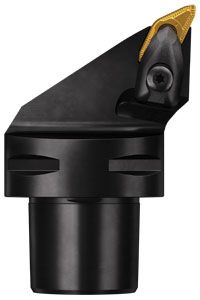by Kip Hanson
Grooving and turning with the same tool is a great way to reduce cycle times and increase available turret stations, yet there’s another type of multidirectional turning, one that offers the same benefits but has many machinists still scratching their heads. It’s called Prime Turning, and according to Sandvik Coromant product and industry specialist Kevin Burton, it’s taking turning to entirely new levels.
“There are two styles of CoroTurn Prime,” he says. “The A-style is triangular shaped, and is designed primarily for finishing and semi-finishing operations, although we have seen good results in light roughing as well. The B-type insert looks a little like a football and is geared more for heavy roughing. Both have shown to increase tool life by an average of at least 50 per cent.”
Longer tool life is great, but what about productivity? Here again, Burton says Prime Turning doesn’t disappoint. “One of my customers here in Canada was using a CNMG insert to turn 432cr stainless steel weld overlays at 120 sfm with a feed rate of 0.006 ipr. By switching to Prime, they increased the speed to 180 sfm and the feed to 0.020 ipr, an increase of 345 per cent. Tool life tripled as well.”
 Burton cites numerous other examples, where everything from Nitronic 60 to Inconel 718 to 1050 steel forgings were turned using Prime; the worst case showed a 14 per cent reduction in cycle time, while the others enjoyed productivity improvements similar to the weld overlay application just mentioned.
Burton cites numerous other examples, where everything from Nitronic 60 to Inconel 718 to 1050 steel forgings were turned using Prime; the worst case showed a 14 per cent reduction in cycle time, while the others enjoyed productivity improvements similar to the weld overlay application just mentioned.
The secret sauce? “The geometry is unique, the carbide is new, but most of the improvement can be attributed to lower temperatures in the cutting area,” Burton says. “With conventional turning, all the heat goes into the nose radius. Prime, on the other hand, spreads cutting forces across a larger portion of the insert edge. It’s the same principle as high feed milling, where the chip thinning effect often provides dramatic improvements in both tool life and productivity.”
